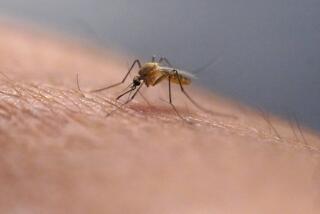Big Increase in Mosquito Population Predicted : Insects: Heavy rains are blamed. Health experts fear an outbreak of encephalitis.
This yearâs heavy rains will probably produce the biggest mosquito population in 20 years, and county health officials are bracing for a possible outbreak of mosquito-transmitted St. Louis encephalitis.
Calls reporting mosquitoes to the Los Angeles County West Vector Control District were higher in February and March than at any other time in the last two decades, said Robert Saviskas, the agencyâs executive director.
The district, covering an area extending from the Westside to Ventura County, is one of five that monitor and attempt to control mosquitoes and other pests throughout Los Angeles County.
Michele Jay, a research scientist with the California Department of Health Services, said mosquitoes carry the virus responsible for St. Louis encephalitis, a viral brain inflammation transmitted from infected birds to humans through the blood carried by the insects.
Areas hit by the Northridge earthquake are particularly vulnerable, because broken swimming pools and back-yard spas make natural breeding grounds for mosquitoes.
âWe canât predict whether or not the virus will be present this year in the mosquito population, but we do predict that with this kind of rain, the mosquito population will be very large,â Jay said.
Jack Hazelrigg, district manager of the Greater Los Angeles County Vector Control District,which monitors the insects in the San Fernando Valley, said his agency is âvery concerned about virus transmission.â
âHigh rainfall creates a habitat ideal for the mosquito suspected (of) transmitting St. Louis encephalitis,â he said.
There is no evidence yet of an encephalitis breakout, said Dr. Laurene Mascola, chief of the countyâs acute communicable disease control unit. Mascola said that last year only three cases were reported in the county, and they may not have been caused by mosquitoes.
St. Louis encephalitis, one of many forms of virally transmitted encephalitis, can cause fatigue, headaches and seizures. It is not treatable with antibiotics, and although most infected people recover quickly, some suffer permanent brain damage or death, said Dr. Carol Peterson, an epidemiologist responsible for monitoring the disease for the county.
âMost of the cases are very mild,â Peterson said, so mild that people may never know they have contracted the disease.
The only treatment is what doctors call supportive care, Peterson said, which involves ensuring that the patient is able to breathe well and take plenty of fluids. Oxygen is sometimes administered.
Young children and the elderly are particularly susceptible, Peterson said, and should stay away from infested areas, particularly at twilight, when the mosquitoes are active.
It is impossible to tell whether the mosquitoes in a particular area are the common and benign southern house mosquitoes or the western encephalitis mosquito, which carries the disease, Hazelrigg said.
But there are precautions that state and county health officials recommend. Mosquitoes breed in standing water--even in pools of water as small as those inside flower petals. So homeowners should remove such things as buckets or old tires that fill with water and drain stagnant pools.
Southern California has averaged one to three confirmed cases of St. Louis encephalitis each year since 1990, Jay said. In 1984, when Los Angeles County had its last major outbreak of the disease, 16 people were hospitalized. Half of them lived in the Valley and probably were bitten by mosquitoes that infest the area near the Sepulveda Basin.
However, Mascola said, it is very hard to track the real incidence of the disease, and it may be more prevalent than the numbers indicate.
Times researcher Stephanie Stassel contributed to this story.
(BEGIN TEXT OF INFOBOX / INFOGRAPHIC)
Mosquito Invasion Heavy rains have resulted in what could be the worst year for mosquitoes in two decades. One culprit is the western encephalitis mosquito, which could spread encephalitis. *
Description: A quarter- inch long, Slender, with a long, needlelike âbeakâ and narrow wings. Males, which live from seven to 10 days, feed on plant juices and do not bite humans. Females, which live 30 days or more, obtain protein needed to lay their eggs from the blood of birds and mammals, sometimes transmitting encephalitis in the process. *
Breeding A female mosquito makes a high- pitched sound with its wings to attract a male. Mosquitos mate only once in a lifetime. They prefer to breed in clear, sunlit water, such as that in abandoned swimming pools and roadside ditches. *
Life Cycle Between 100 and 300 eggs are laid on water or damp ground in an arrangement that looks like small raft. They hatch in two or three days in warm weather. Larvae feed on small aquatic plants and animals, then molt into active pupae after 4- 10 days. Adults emerge two to five days later. *
Range Found mostly in Western states. Sources: Greater Los Angeles County Vector Control District; Audubon Society Pocket Guide; Familiar Insects and Spiders and World Book.
More to Read
Sign up for Essential California
The most important California stories and recommendations in your inbox every morning.
You may occasionally receive promotional content from the Los Angeles Times.










